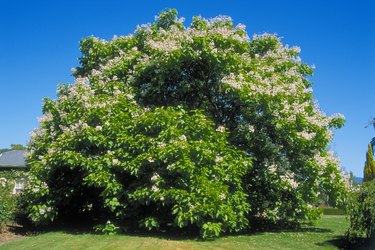
Growing a catalpa tree (Catalpa spp.) from seed is a long-term project, but worth it for the large clusters of white flowers mature trees bear in late spring. Catalpa trees that are common garden favorites include southern catalpa (Catalpa bignonioides, USDA zones 5-9), northern catalpa (Catalpa speciosa, zones 4-8) and Chinese catalpa (Catalpa ovata, zones 4-8). The seeds of all three trees grow best in a moist, protected site. Catalpa trees are invasive in some areas of the United States.
Catalpa Seed Pods
Video of the Day
Catalpa seeds must be ripe before sowing, and some seeds need exposure to cold temperatures. Catalpa seed pods turn brown in fall, and split open to release the ripe seeds.
Video of the Day
Collect southern catalpa and Chinese catalpa seed pods as they begin to open. These seeds are ready for sowing outdoors after collection, or you can store them in a cool, dry place for sowing in spring. Three weeks before you plan to sow them, place the stored seeds in a refrigerator to expose the seed to cold temperatures, which triggers sprouting.
Collect nothern catalpa seeds in late winter and place them in paper envelopes or bags. Store them in in a cool, dry place until summer until the seeds are sown.
Sowing Catalpa Seeds
Well-draining, moist soil is essential for sowing catalpa tree seeds. Sow the seeds in well-draining potting soil in 3-inch pots, or in well-drained soil in a cold frame in a partial-shade site. All pots for catalpa seedlings must have drainage holes.
Place three or four seeds equally spaced on the potting soil surface, or space them 1 inch apart in the cold frame, and cover the seeds to their own depth in soil. The University of Florida Extension recommends covering catalpa seeds with a shallow layer of pine needle mulch.
Water the seeds with a fine rose spray attachment on a watering can or garden hose until the water flows from the pot drainage holes or until the soil in the cold frame is moist to a depth of 3 inches. Place catalpa seed pots in a sheltered, partial-shade outdoor spot, and leave the lid open on the cold frame. Water the seeds when the soil surface is dry.
Transplanting Catalpa Tree Seedlings
In about four to six weeks, when the catalpa tree seedlings are 2 to 3 inches tall with two developed leaves, fill clean 3-inch pots with fresh, well-drained potting soil. Make a hole in the soil with a chopstick or similar tool, and remove a seedling from its pot or cold frame by gently holding a leaf and loosening the soil around the seedling with the chopstick. Place the seedling in the hole in the new pot at its original growing depth and gently fill in the gaps around its roots with potting soil.
Transplant the rest of the catalpa seedlings in the same way, and place them in a partial-shade, sheltered area outdoors. Water the pots when the soil surface is dry, and transplant the seedlings into pots the next size up when their roots fill their pots. Grow catalpa seedlings in pots over the first winter, and plant them in the garden in spring or summer the following year. Fresh potting soil provides nutrients for the seedlings, so they don't require fertilizer.
Growing Young Catalpa Trees
A full-sun or partial-shade, moist site is best for growing young catalpa trees. These trees tolerate a range of growing conditions including dry soils, but they thrive in fertile loam soil in moist areas such as near ponds or streams, and low-lying sites. Catalpa trees tolerate heavy clay soil and seasonal flooding, and southern catalpa and Chinese catalpa also tolerate air pollution. Plant young catalpa trees after the final average frost date for your area.
- Missouri Botanical Garden: Catalpa Bignonioides
- Missouri Botanical Garden: Catalpa Speciosa
- Missouri Botanical Garden: Catalpa Ovata
- Plants For a Future: Catalpa Bignonioides
- Plants For a Future: Catalpa Ovata
- University of Florida IFAS Extension: Catalpa Speciosa
- University of Florida IFAS Extension: Catalpa Spp -- Catalpa
- Purdue University Consumer Hortculture: Growing Trees from Seed